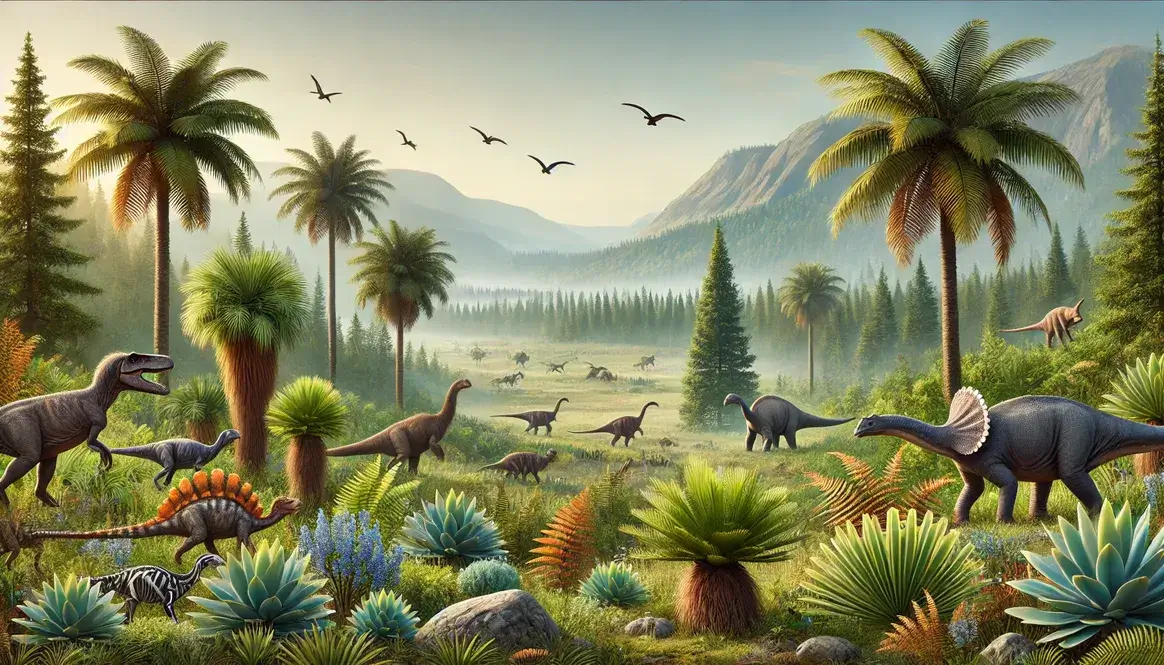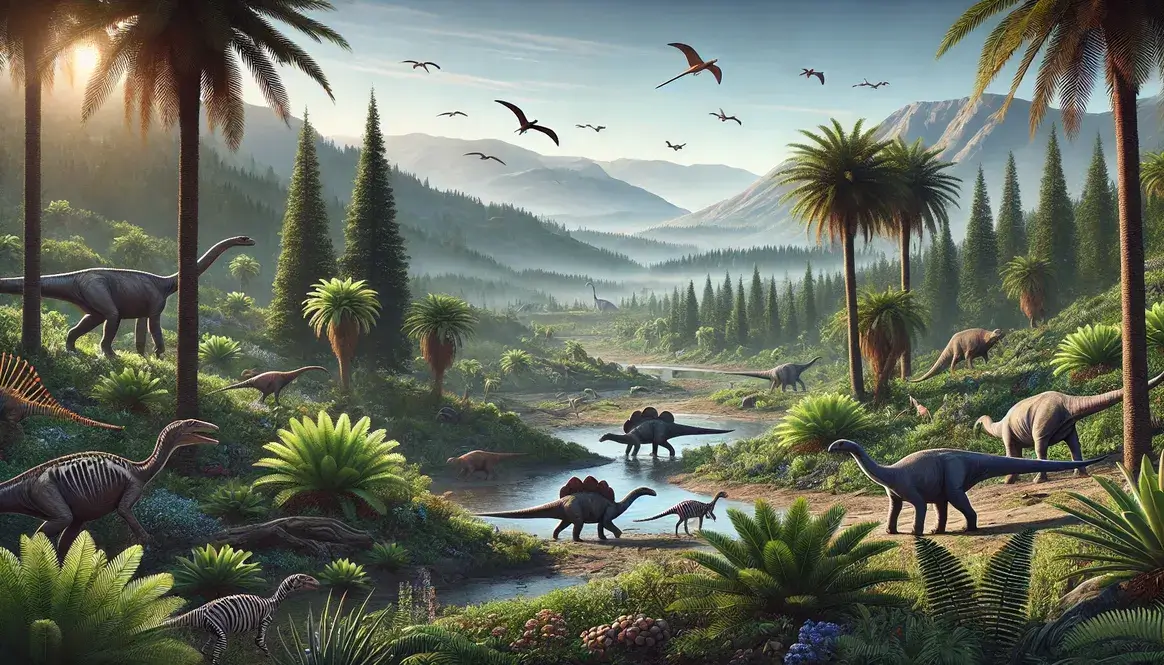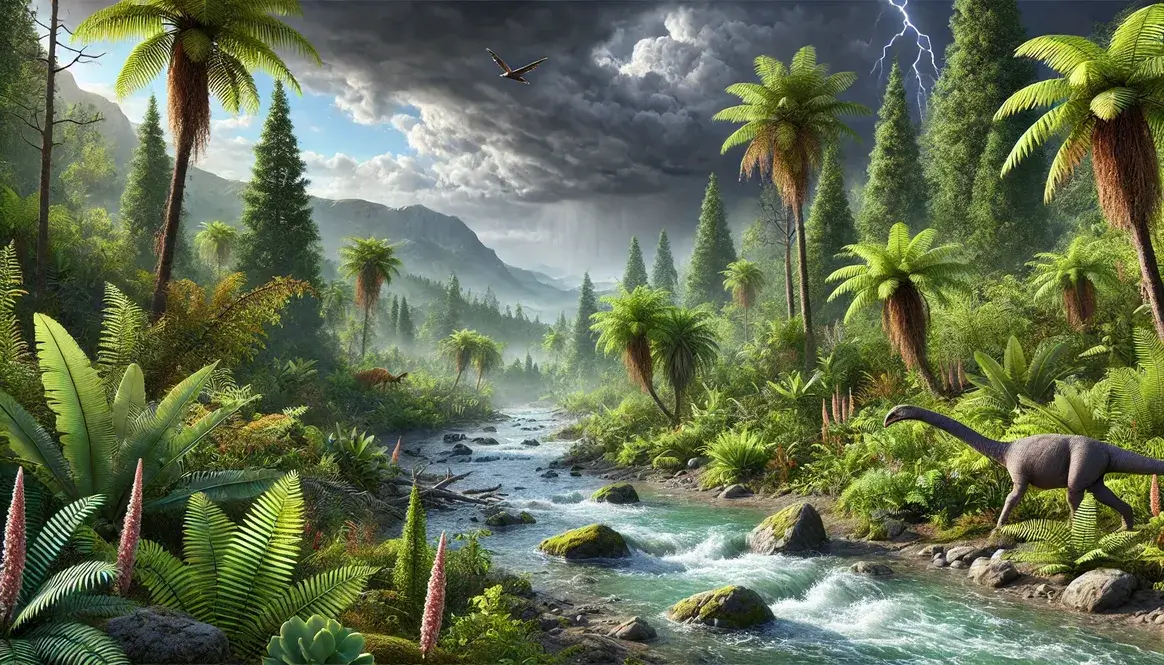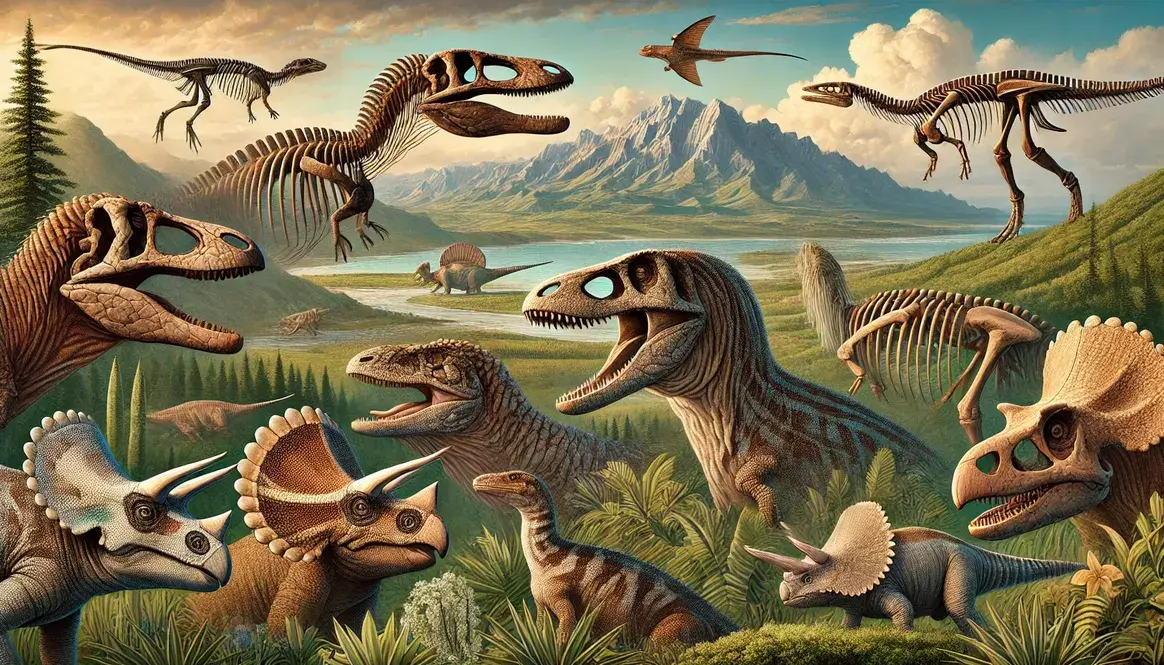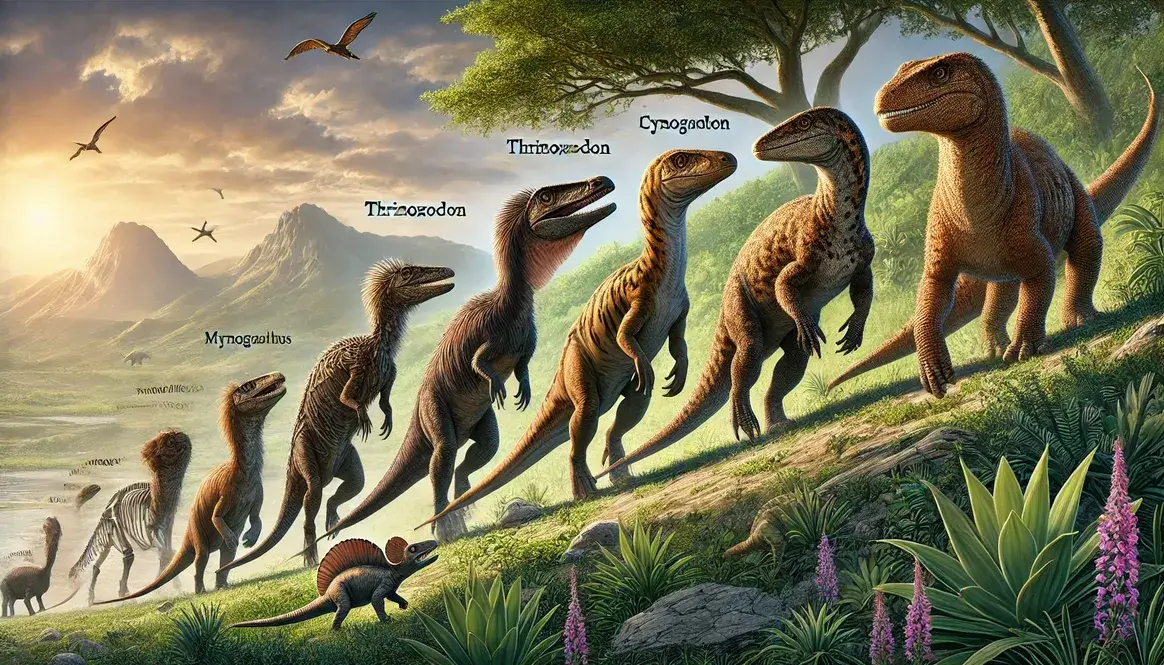Picture a world where the first dinosaurs are just starting to roam, and the air is thick with carbon dioxide. Welcome to the Triassic period, a time of great change and opportunity for plants! The Triassic, which lasted from about 252 to 201 million years ago, was a turning point for plant evolution. It set the stage for the lush, green world we know today.
After the devastating Permian-Triassic extinction event, which wiped out most of Earth’s species, Triassic plants found themselves in a world ripe for colonization. These hardy survivors and their descendants became the pioneers of a new era, adapting to harsh conditions and paving the way for the diverse ecosystems of the Jurassic period.
Major Plant Groups of the Triassic
The Triassic saw a mix of ancient plant lineages and new innovations. Let’s explore the main players in this prehistoric botanical world!
Ferns and Fern Allies
Ferns were the comeback kids of the Triassic. These leafy wonders had been around since before the dinosaurs, but they really hit their stride in this period.
- Diversity: Ferns came in all shapes and sizes, from tiny ground-huggers to tree-like giants.
- Adaptations: Many ferns developed thick, waxy coatings on their leaves to prevent water loss in the hot Triassic climate.
Fern allies, like horsetails and club mosses, also thrived. These plants, which reproduce using spores instead of seeds, were particularly good at colonizing disturbed areas.
Cycads and Cycadeoids
If you’ve ever seen a palm tree, you can imagine what a cycad looks like. These seed plants were a big deal in the Triassic.
- Characteristics: Cycads have a thick trunk and a crown of large, compound leaves. They’re pretty tough customers, able to withstand drought and poor soils.
- Ecosystem role: Cycads were an important food source for herbivorous reptiles, including some early dinosaurs.
Cycadeoids, also known as Bennettitales, looked similar to cycads but weren’t closely related. They played a similar role in Triassic ecosystems and became even more important in the Jurassic.
Ginkgophytes
Believe it or not, the ginkgo trees in your local park have relatives that lived in the Triassic!
- Features: Early ginkgophytes had fan-shaped leaves, much like modern ginkgo trees.
- Niche: These trees were often found in riverside forests, their leaves fluttering in the Triassic breeze.
Ginkgophytes were survivors, able to withstand harsh conditions that would have knocked out less hardy plants.
Conifers
Conifers, the group that includes modern pines and firs, really came into their own during the Triassic.
- Emergence: Conifers evolved from seed fern ancestors and quickly spread across the landscape.
- Adaptations: Their needle-like leaves and thick bark helped them conserve water in the often dry Triassic climate.
Conifers became the dominant trees in many Triassic forests, setting the stage for their continued success throughout the age of dinosaurs.
Evolution of Gymnosperms in the Triassic
The Triassic was a time of big changes for seed plants, particularly gymnosperms (plants with “naked” seeds not enclosed in fruit).
From Seed Ferns to Modern Gymnosperms
As the Triassic dawned, the plant world was in flux. Seed ferns, which had dominated in the Paleozoic era, were on their way out.
- Transition: Seed ferns gave way to more advanced gymnosperms like conifers and cycads.
- Innovations: New reproductive strategies emerged, like more efficient pollen dispersal mechanisms.
Diversification of Conifers
Conifers didn’t just survive in the Triassic—they thrived!
- Expansion: New conifer families appeared, each adapted to different environments.
- Adaptations: Conifers developed features like winged seeds for better dispersal and resin production for defense against pests.
| Conifer Family | Key Features | Ecological Role |
|---|---|---|
| Voltziales | Ancestor to modern conifers | Dominant in early Triassic forests |
| Podocarpaceae | Broad leaves, fleshy seed structures | Important in Southern Hemisphere |
| Araucariaceae | Large cones, spiral leaf arrangement | Widespread in late Triassic |
Rise of the Bennettitales
The Bennettitales, or cycadeoids, became an important part of Triassic ecosystems.
- Characteristics: These plants looked like cycads but had more complex reproductive structures.
- Significance: Bennettitales may have been among the first plants to develop flower-like structures, hinting at the future evolution of flowering plants.
The Triassic was a time of innovation and adaptation for plants. As they spread across the recovering landscape, Triassic plants laid the groundwork for the diverse and complex ecosystems that would support the giant dinosaurs of later periods. These botanical pioneers truly were the unsung heroes of the dinosaur era!
You’re absolutely right. Let’s mix it up with a variety of formatting to make the content more engaging and readable. Here’s a revised version:
Plant Adaptations to Triassic Climate
The Triassic threw everything it had at plants – scorching heat, parched deserts, and swampy wetlands. But these green pioneers were up for the challenge!
Coping with Warm and Dry Conditions
Imagine trying to survive in a world where rain is scarce and the sun beats down relentlessly. That’s what Triassic plants faced in many areas, especially in the heart of Pangaea. But they didn’t just survive – they thrived!
Conifers became masters of water conservation with their needle-like leaves. These leaves, with less surface area than broad, flat ones, lost less water to evaporation. Many plants also developed thick, waxy coatings on their leaves – nature’s own plastic wrap – to keep precious moisture in.
| Adaptation | Function | Examples |
|---|---|---|
| Thick cuticle | Reduces water loss | Cycads, conifers |
| Sunken stomata | Conserves water | Many gymnosperms |
| Deep root systems | Accesses underground water | Desert-dwelling plants |
But the real game-changer was happening inside the plants. Some species evolved a new, more efficient way of photosynthesis called C4. This allowed them to make food even when it was too hot for other plants to function.
Surviving in Triassic Wetlands and Mountains
Not all of the Triassic was a desert, though. In low-lying areas, swamps and wetlands formed lush oases. Here, plants like horsetails and certain ferns ruled supreme. They developed a nifty trick called aerenchyma – essentially, internal air channels that allowed their roots to “breathe” even when submerged.
Meanwhile, up in the mountains, a different story was unfolding. High-altitude plants had to cope with cooler temperatures and even occasional frost. Some developed natural “antifreeze” in their cells, allowing them to survive in chilly conditions that would have killed their lowland cousins.
Impact of Plants on Triassic Ecosystems
Triassic plants weren’t just passive bystanders – they were actively shaping the world around them. Here’s how:
- Soil creation: Plant roots broke up rocks and added organic matter to the soil.
- Erosion control: Roots held soil in place, while leaves broke the fall of raindrops.
- Habitat formation: Plants created diverse environments for animals to live in.
A World of Interactions
The Triassic saw the beginning of many fascinating plant-animal relationships:
- Insect coevolution: Plants and insects entered an evolutionary arms race, each developing new strategies to outwit the other.
- Reptile buffet: Plants provided food for herbivorous reptiles, including some early dinosaurs.
- Shelter and nesting: The first pterosaurs and other animals used plants for protection and raising young.
The Big Picture: Plants and the Triassic World
Perhaps the most profound impact of Triassic plants was on the global climate. As forests spread across the land, they absorbed massive amounts of carbon dioxide from the atmosphere. This gradual removal of greenhouse gases helped cool the planet over millions of years.
This cooling effect may have set the stage for the Carnian Pluvial Event, a period of increased rainfall that had far-reaching effects on Triassic life. It’s a powerful reminder that plants don’t just respond to climate – they help shape it.
Triassic Plants: Foundation for Mesozoic Life
As the Triassic drew to a close, the stage was set for the next act in Earth’s history. The plants of this period had done more than just survive – they had transformed the world:
- They created the forests that would later support giant sauropods.
- They kick-started coevolutionary relationships that would lead to the evolution of flowering plants.
- They began the process of carbon sequestration that would help regulate Earth’s climate for millions of years to come.
The end-Triassic extinction would once again reset the board, but the evolutionary innovations of Triassic plants would carry forward. From the humble ferns to the towering conifers, these plants were the true pioneers of their time, paving the way for the incredible diversity of the Jurassic and Cretaceous periods.
So the next time you see a cycad in a botanical garden or a ginkgo tree on a city street, take a moment to appreciate their ancient lineage. These are the descendants of some of the toughest, most adaptable organisms in Earth’s history – the plants that helped shape the world of dinosaurs!

